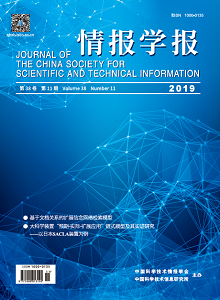 |
|
2019 Vol. 38, No. 11
Published: 2019-11-28 |
|
|
| |
|
|
|
|
|
1129 |
Analysis of Research Hotspots in the Field of Global Medical Research Based on Natural Index Hot! |
|
 |
Yang Ying, Xu Dan, Chen Sisi, Han Shuang, Xu Shuang |
|
|
DOI: 10.3772/j.issn.1000-0135.2019.11.001 |
|
|
Since the Natural Index was proposed in 2014, research has progressively increased on existing indicators, but scientometric analysis based on basic data is relatively scarce. Scientific quantitative analysis is based on publications in Natural Index journals in the field of global medical research. Based on the theories of co-word analysis and co-occurrence network, scientific measurement tools such as BICOMB and Ucinet are used to analyze the social network structure of research hotspots of the past two years. Additionally, the gCluto software is used for biclustering the word-article matrix to explore research frontiers. This research reveals the hotspots of global medical research, provides a reference for the development direction of the field, and analyzes the advantages and disadvantages of the Natural Index in the evaluation of scientific research. |
|
|
2019 Vol. 38 (11): 1129-1137
[Abstract]
(
337
)
HTML
(95 KB)
PDF
(7240 KB)
(
455
) |
|
|
|
1138 |
Research on the Influence of Social Interaction on User Perception and Information Adoption of the Recommendation System Hot! |
|
 |
Li Zhi, Sun Rui |
|
|
DOI: 10.3772/j.issn.1000-0135.2019.11.002 |
|
|
The personalized recommendation system (PRS) generates recommendation information by considering the preferences of target users and similar users. In this study, based on the situational experiment analysis, participantsevaluation of PRS is obtained based on social interaction by changing the level of social interaction (social reference and self-reference) and using six PRSs for the application to establish the experimental operation under the Web. Moreover, the experimental data are analyzed and processed by SPSS23.0 and Smart PLS2.0 software. The results indicate that the social interaction environment significantly improved the perceived accuracy and novelty of PRS. The results also confirm the positive impact of perceived accuracy and novelty on user satisfaction and that of satisfaction and perceived novelty on information adoption. In addition, the research verifies the mediating effect of perception accuracy, novelty perception, and satisfaction. This study aims to explore the influence of social interaction on perceived accuracy and novelty, which, in turn, affect satisfaction and information adoption. By integrating the functions of PRS and social interaction, we can improve our understanding of social cognitive processes related to PRS user perceptions. |
|
|
2019 Vol. 38 (11): 1138-1149
[Abstract]
(
350
)
HTML
(155 KB)
PDF
(1083 KB)
(
991
) |
|
|
|
1150 |
Research on Altmetrics Evaluation Model of Academic Conference Based on GBDT Hot! |
|
 |
Zhang Yang, Ye Yue, Zhang Zongxiang, She Fang, Chen Xiyu |
|
|
DOI: 10.3772/j.issn.1000-0135.2019.11.003 |
|
|
In order to spread and share academic achievements in a certain field, academic conferences serve as an inevitable and important part in the development of that subject field. In certain cases, academic conferences are favored by researchers because of their timely dissemination of knowledge. This paper collects relevant data from altmetrics indicators—Altmetrics. com and PlumX—on the international conferences on artificial intelligence from 2007 to 2014, with the help of descriptive statistics and gradient lifting decision tree. Using indicators screening, data imbalance processing, and model optimization, a meeting evaluation model based on the gradient lifting decision tree was formed. This model combines popular machine learning models with latest altmetrics indexes. It can effectively cover the deficiencies of traditional informetrics indicators and improve the accuracy of the conference evaluation model, which can enrich related research on conference evaluation and become a reference for future research. |
|
|
2019 Vol. 38 (11): 1150-1159
[Abstract]
(
358
)
HTML
(115 KB)
PDF
(1935 KB)
(
925
) |
|
|
|
1166 |
Multi-source Information Fusion Analysis for Emerging Technology Development Trend Identification, Using Blockchain as an Example Hot! |
|
 |
Zhang Weichong, Wang Fang, Zhao Hong |
|
|
DOI: 10.3772/j.issn.1000-0135.2019.11.005 |
|
|
The scientific literature is constantly being enriched, and has become valuable quantitative analysis data. The information fusion analysis of different sources and different types of scientific and technical literature can provide powerful information support for comprehensively revealing the development status and trends of emerging technologies. The efficient acquisition of topics from multi-source heterogeneous data is a technical difficulty in solving the problem of “subject” measurement entities in multi-source information fusion. This article is aimed at studying seven different scientific and technical literature types: patents, journal articles, dissertations, conference papers, books, funding projects, and industry reports. A summary-based topic analysis method is proposed. The topic words are obtained from multi-source heterogeneous texts, and data fusion and topic association analysis are performed. The results are effective and efficient, which provides a reference for solving the problem. In the experiment, blockchain is taken as an example. Based on data fusion, sequential association analysis and topic association analysis are carried out to reveal the development of blockchain technology. The results show that the method effectively reveals the production process, the theme diffusion, and the evolution trajectory of blockchain technology innovation in the scientific literature. |
|
|
2019 Vol. 38 (11): 1166-1176
[Abstract]
(
388
)
HTML
(95 KB)
PDF
(3129 KB)
(
1830
) |
|
|
|
1187 |
The “Expected-Actual-Extended Application” Chain Model, and an Empirical Study of Large Scientific Facilities, Taking SACLA as an Example Hot! |
|
 |
Guo Shijie, Wang Xuezhao, Han Tao, Wei Ren, Dong Lu, Li Yizhan, Li Zexia |
|
|
DOI: 10.3772/j.issn.1000-0135.2019.11.007 |
|
|
To reveal the potential applications of large scientific facilities, topic analyses on three levels (conceived application, actual application, and extended application) are proposed, using three kinds of data (experimental research proposals, scientific results, and citations in papers), with the analysis process including natural language processing, co-occurrence clustering, and bibliographic coupling. On this basis, an “expected-actual-extended application” chain model of large scientific facilities is summarized. The Spring-8 Compact Free Electron Laser (SACLA), a Japanese hard X-ray free electron laser, is studied as an example. The potential applications of SACLA in various scientific and technical fields are then discussed. |
|
|
2019 Vol. 38 (11): 1187-1199
[Abstract]
(
365
)
HTML
(91 KB)
PDF
(9096 KB)
(
567
) |
|
|
|
1200 |
Research on the Discovery of Entity Relationships in Subdivided Domains under the Guidance of a Small-scale Knowledge Base Hot! |
|
 |
Chen Guo, Xu Tianxiang |
|
|
DOI: 10.3772/j.issn.1000-0135.2019.11.008 |
|
|
The acquisition of entity relationships in subdivided domains is a key issue for deepening and generalizing applications of knowledge engineering. In order to tackle the core problem of heavy reliance on manually annotated corpus at present, a natural solution is to use the existing (or low-cost) knowledge base in the subdivided domains as a guide. In contrast to the general knowledge base, the domain knowledge base is often small. This means it is necessary to not only use the ready-made knowledge content, but also to fully explore the “domain meta-knowledge” contained in the domain knowledge base. This paper proposes a subdivided domain entity relationship discovery scheme that combines domain meta-knowledge and a word embedding vector analogy. First, this paper describes the entity relationship constraints of a specific subdivided domain based on the existing knowledge base, such as the symptom representation relationship, which consists of <disease, symptom> entity pairs. Secondly, the word embedding vector of the domain entity is calculated according to the corresponding domain corpus. Following this, the positive and negative case vector benchmarks of various relational word embedded analogies are learned to provide a small number of high-quality entity relationships in the knowledge base, with the entity relationship classifier then trained based on this. Finally, for a given domain entity, by combining relational constraints, word embedding similarity, and word embedding analogy results, the entities that form different types of relationships are obtained. Taking the cardiovascular data as an example, a small amount of domain knowledge extracted from the encyclopedia can be used to obtain a better entity relationship recognition effect. |
|
|
2019 Vol. 38 (11): 1200-1211
[Abstract]
(
265
)
HTML
(132 KB)
PDF
(2432 KB)
(
828
) |
|
|
|
1222 |
A Review of Word Representation Learning Hot! |
|
 |
Pan Jun, Wu Zongda |
|
|
DOI: 10.3772/j.issn.1000-0135.2019.11.010 |
|
|
Word representation that reflects semantic meaning is fundamental to natural language understanding tasks. The traditional method of encoding a word through a semantic dictionary is impractical due to the high construction cost, and one-hot representation suffers from various defects, such as high dimension and data sparsity. Distributed word representation,which projects the words into vectors in a low-dimensional real-valued space, can capture the semantic relatedness between the words and has been widely used in many NLP tasks. In this paper, we present an in-depth study of word representation learning methods from the perspectives of input data, learning objectives, and optimization algorithms, focusing on the theoretical basis, key techniques, evaluation methods, and application fields. We then summarize the main challenges and the latest advances in this research field, and we finally discuss possible future work in the field. |
|
|
2019 Vol. 38 (11): 1222-1240
[Abstract]
(
267
)
HTML
(402 KB)
PDF
(2532 KB)
(
1399
) |
|
|
|


